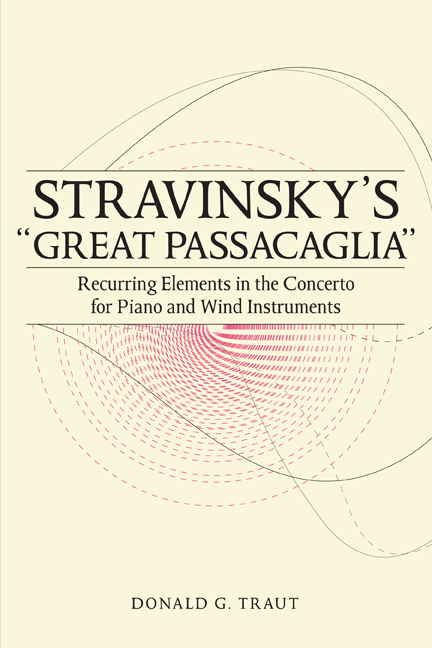Book contents
- Frontmatter
- Dedication
- Contents
- Acknowledgments
- Introduction
- 1 Context and Composition
- 2 Concerto as Catalyst
- 3 Analytical Tools and Recurring Elements
- 4 Counterpoint and Tonality in the First Movement
- 5 Tetrachords and Tritones in the Largo
- 6 Points of Imitation in the Finale
- Conclusion
- Appendix
- Notes
- Bibliography
- Index
2 - Concerto as Catalyst
Published online by Cambridge University Press: 12 August 2020
- Frontmatter
- Dedication
- Contents
- Acknowledgments
- Introduction
- 1 Context and Composition
- 2 Concerto as Catalyst
- 3 Analytical Tools and Recurring Elements
- 4 Counterpoint and Tonality in the First Movement
- 5 Tetrachords and Tritones in the Largo
- 6 Points of Imitation in the Finale
- Conclusion
- Appendix
- Notes
- Bibliography
- Index
Summary
As we learned in chapter 1, Stravinsky had a somewhat frantic time completing the Concerto in the spring of 1924. In part, this was due to the increasingly prominent role other facets of his life began to play. Conducting began to consume an increasingly large amount of his time. Further, his decision to perform the Concerto himself set off a chain of events that form the crux of this chapter. As he continued to manage all the facets of the piece's performance— from performing to negotiating to handling the press—his exposure and notoriety just kept climbing. Looking back now, it becomes even clearer what a turning point this was in Stravinsky's life. The spotlight that had shined on him for the three early ballets had perhaps dimmed a bit. The war had impacted everyone. His first few neoclassic pieces were largely misunderstood. Indeed, Stravinsky sought something profound to help him reenter the public eye. With these points in mind, this chapter presents four ways that Stravinsky's Concerto was a catalyst for change. The first section considers how his decision to perform the piece himself affected his life. Second, we see how his relations with the press heightened the “back to Bach” fervor already in the air. Third, we explore the ramifications of this fervor, specifically as it relates to his relations with two prominent proponents of the German musical tradition, Arnold Schoenberg and Heinrich Schenker. Finally, we see how the piece influenced Stravinsky scholarship and other composers over the years.
Stravinsky the Performer
At the age of forty-two, with little to no experience as a featured soloist, the world's premier modern composer began performing his own new compositions. “Now that's brave!” wrote Prokofiev. Stravinsky knew the risk involved. Why invite this extra scrutiny from a public already confused by recent neoclassic offerings? Why invest the time needed to practice and tour at the expense of generating new compositions? There are at least two ways to answer these questions. The fi rst is artistic: as Stravinsky saw it, no one was more qualified to premiere his new piano concerto than himself. Performances by the composer would ensure that, at least for a time, the piece would receive proper treatment. The other is more practical: he needed money.
- Type
- Chapter
- Information
- Stravinsky s "Great Passacaglia"Recurring Elements in the Concerto for Piano and Wind Instruments, pp. 32 - 50Publisher: Boydell & BrewerPrint publication year: 2016

